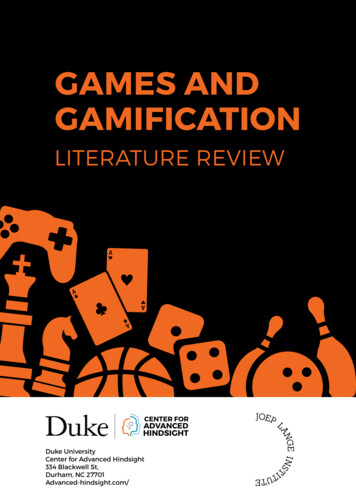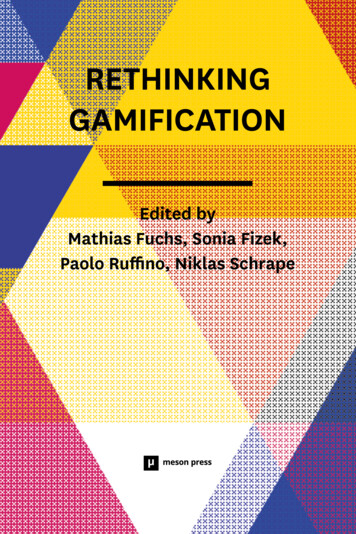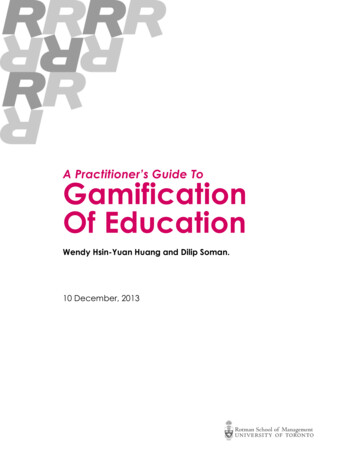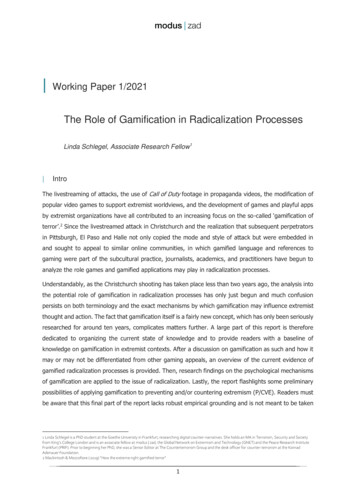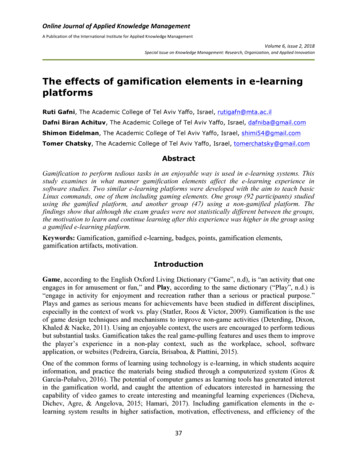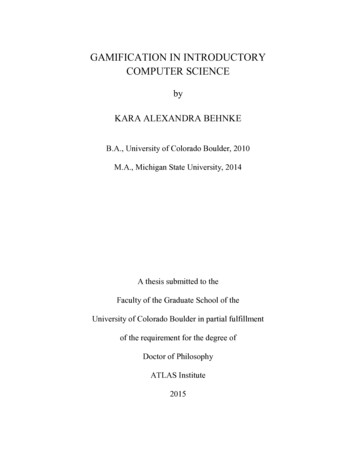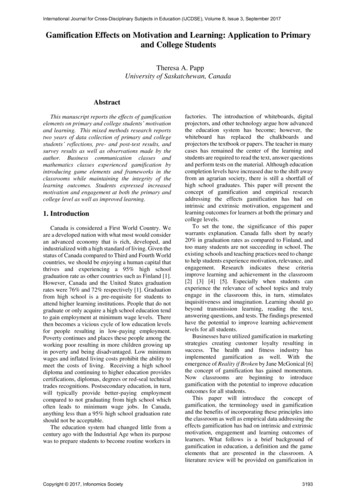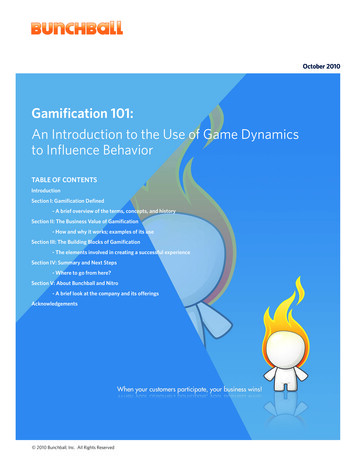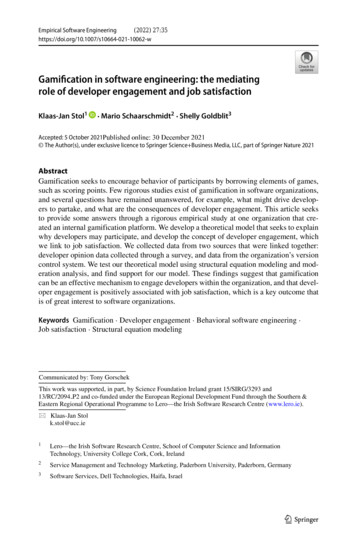
Transcription
Empirical Software Engineering(2022) ification in software engineering: the mediatingrole of developer engagement and job satisfactionKlaas-Jan Stol1· Mario Schaarschmidt2 · Shelly Goldblit3Accepted: 5 October 2021 The Author(s), under exclusive licence to Springer Science Business Media, LLC, part of Springer Nature 2021AbstractGamification seeks to encourage behavior of participants by borrowing elements of games,such as scoring points. Few rigorous studies exist of gamification in software organizations,and several questions have remained unanswered, for example, what might drive developers to partake, and what are the consequences of developer engagement. This article seeksto provide some answers through a rigorous empirical study at one organization that created an internal gamification platform. We develop a theoretical model that seeks to explainwhy developers may participate, and develop the concept of developer engagement, whichwe link to job satisfaction. We collected data from two sources that were linked together:developer opinion data collected through a survey, and data from the organization’s versioncontrol system. We test our theoretical model using structural equation modeling and moderation analysis, and find support for our model. These findings suggest that gamificationcan be an effective mechanism to engage developers within the organization, and that developer engagement is positively associated with job satisfaction, which is a key outcome thatis of great interest to software organizations.Keywords Gamification · Developer engagement · Behavioral software engineering ·Job satisfaction · Structural equation modelingCommunicated by: Tony GorschekThis work was supported, in part, by Science Foundation Ireland grant 15/SIRG/3293 and13/RC/2094 P2 and co-funded under the European Regional Development Fund through the Southern &Eastern Regional Operational Programme to Lero—the Irish Software Research Centre (www.lero.ie). Klaas-Jan Stolk.stol@ucc.ie1Lero—the Irish Software Research Centre, School of Computer Science and InformationTechnology, University College Cork, Cork, Ireland2Service Management and Technology Marketing, Paderborn University, Paderborn, Germany3Software Services, Dell Technologies, Haifa, Israel
35Page 2 of 34Empir Software Eng(2022) 27:351 IntroductionPerhaps the most valuable resource of a software organization is its developers: it is thepeople within the organization that design, create, develop, and ship the software. Ensuringthat developers are satisfied in their job is important, as this is a strong predictor of anintention to leave the organization (Sharma and Stol 2020). Understanding what increasesdevelopers’ job satisfaction is therefore useful to organizations. Besides keeping developershappy, organizations may wish to encourage certain types of behavior, for example, sharingcode and knowledge. One potential tactic to influence people’s behavior is gamification, atechnique that is applicable in many different contexts and which has also been explored insoftware engineering (Dubois and Tamburrelli 2013; Fraser 2017; Dal Sasso et al. 2017).The Oxford English Dictionary (www.oed.com) defines gamification as follows:The action or process of making something into or like a game; spec. the applicationof elements of game playing (such as point scoring, competition with others, etc.) toother areas of activity, typically to encourage engagement with a product or service.This suggests that by gamifying a process, participants’ engagement may increase. Whilethe phrase “engagement with a product or service” in the definition above might imply thatparticipants are end-users or customers, in a software development context these participantsare software developers.The term gamification was first coined in 2002 by Nick Pelling, a game developer (Marczewski 2013, p. 24). Studies of gamification in software engineering literature tend tofocus on gamification techniques in software products (gamified software), gamification ofthe development process, or gamification in software engineering education. In all threestrands of research, the focus tends to be on increased engagement. For gamified softwarethis means increased engagement of end-users, and as suggested above, for gamification ofthe development process this means increased engagement of developers.In this article we focus on gamification of the development process. We observed a number of shortcomings in the gamification literature. First, few rigorous empirical studies havefocused on gamification mechanisms in industry contexts with professional developers, witha few notable exceptions (Herranz et al. 2018; Snipes et al. 2014; Neto et al. 2018; Marques et al. 2020). Many papers in this domain propose conceptual frameworks or new tools,some of which have been empirically evaluated. Several studies have been conducted withstudents, and while qualitative findings suggest that gamification techniques have positiveeffects in terms of sound software engineering practices, many of the quantitative studieshave not found conclusive evidence in favor of gamification in software engineering. Wesuggest that one potential reason for this is that prior quantitative studies have focused onanalyzing direct relationships between variables, whereas these relationships may be muchmore complicated in reality. For example, relationships between variables may be mediatedby a third variable which acts as a ‘mechanism’ that explains how the criterion and outcomevariable (e.g. quality of code or documentation) are related. In this study, we investigatethe link between gamification participation and job satisfaction, and posit that developerengagement is such a mediating mechanism.While several studies have suggested that gamification links to an increase in engagement of developers, the term “developer engagement” has not been clearly defined in thesoftware engineering literature. Thus, this is a second shortcoming in the software engineering literature. Without a clear definition, it is challenging to interpret what “increasedengagement” means as it pertains to software developers. The use of the term engagementis often conflated with ‘participation,’ but the latter is a distinct concept and mixing these
Empir Software Eng(2022) 27:35Page 3 of 34 35terms hinders precise measurement. Based on prior literature, we propose a definition thatcan be used in our study of developer engagement.Third, we lack an understanding of why software developers might participate in gamification initiatives. Much of the prior work in this area has investigated whether gamificationof software development tasks can lead to outcomes such as better quality of code or documentation (Dubois and Tamburrelli 2013), developer motivation (Herranz et al. 2015), oradoption of tools (Snipes et al. 2014). Numerous studies also have studied motivationalaffordances, such as points and badges (Hamari et al. 2014). Such motivational affordances,however, exist within an existing gamification initiative—that is, participants are alreadyactive at that point. To the best of our knowledge, very little research has focused on whatmight draw software developers to a gamification initiative in the first place. Based onprior literature and Personal Investment theory (Beecham et al. 2008; Dubois and Tamburrelli 2013; Braskamp 2009), we suggest that developers seeking to learn new skills andtechnologies are drawn to gamification challenges that offer such learning opportunities.Fourth, while engagement is typically considered as a positive outcome, one might wonder what benefits having engaged software developers offers to software organizations.Very little research indeed has focused on the consequences of having engaged developers(Alhammad and Moreno 2020). What positive outcomes might an organization expect fromengaged developers? In this article, we theorize that gamification may help to achieve anoutcome that is of particular interest to software organizations: job satisfaction (Sharma andStol 2020). We study the relationship between developer engagement and job satisfaction,the latter being a well-known predictor of employees’ intention to stay in their job.We conducted a firm-level survey study at one organization that had started a gamification platform to encourage developers to start collaborating across teams. To focus ourstudy, we developed a theoretical model (see Section 3) grounded in prior literature, whichwe subsequently sought to test using structural equation modeling (Section 4). To that end,we collected sample data from two sources, namely a developer survey and the company’sGitLab installation. The results of our analysis provide empirical support for our model(Section 5). We find that developers participate in the company’s gamification challenges tolearn new skills and technologies, but that participation is moderated by the level of expertise that developers already have. Further, the results of our analysis show that participationis associated with a higher level of developer engagement. This, in turn, is positively andsignificantly associated with job satisfaction, an outcome that should be of great interest tosoftware organizations (Aurum et al. 2008; França et al. 2020; Sharma and Stol 2020). Weconclude by discussing these findings and implications for practice and research.2 BackgroundDeterding et al. (2011) proposed a “soundbite” definition of gamification: the use of gamedesign elements in non-game contexts. Gamification seeks to change people’s behaviorthrough increasing their motivation to act (Richter et al. 2015). It does so through motivational affordances (Hamari et al. 2014); these include giving awards, points, or badgeswhen a person completes a task, or increasing a person’s level or rank as they participateover time (Hamari et al. 2014; Richter et al. 2015). The value of points or a rank doesnot solely lie in having them, but in the implied reputation, identification with a certaingroup, or social approval (Deterding 2012). The use of avatars is another technique, wherebythe avatar represents the person participating in the gamified process. Gamification seeksto entice participants to exhibit certain behavior—and in a software engineering context,
35Page 4 of 34Empir Software Eng(2022) 27:35examples include the writing of better quality documentation, better commit messages, towriting more tests.In the remainder of this section we summarize prior work on gamification in software engineering (Section 2.1). We then focus on the concept of developer engagement,which has remained largely undefined within the SE literature, and provide a definition(Section 2.2).2.1 Gamification in Software EngineeringWhereas gamification is a topic that could be applied in any domain, in this section wefocus specifically on gamification in a software engineering context. Several scholars haveidentified gamification as a potentially useful approach in software engineering (Yilmazet al. 2019; Fraser 2017; Dal Sasso et al. 2017). Numerous review papers have reportedoverviews of gamification in software engineering (Alhammad and Moreno 2020; Pedreiraet al. 2015; Alhammad and Moreno 2018; Mäntylä and Smolander 2016; Garcı́a et al. 2017;Machuca-Villegas and Gasca-Hurtado 2018); a recent tertiary study identified no fewer than12 secondary studies (Garcı́a-Mireles and Morales-Trujillo 2019). The software engineeringliterature that has focused on gamification consists primarily of three strands:–––Gamification of the software product. These efforts focus on incorporating gamificationelements into a product that ultimately seek to change end-user behavior (Morschheuseret al. 2018; Vargas-Enriquez et al. 2015).Gamification of the software development process. These efforts focus on incorporating gamification elements into the develpment process that seek to change developerbehavior (Garcı́a et al. 2017; Marques et al. 2020).Gamification of software engineering education. These efforts focus primarily on theuse of gamification techniques in the teaching of software engineering to students, andas such seek to change student behavior (Alhammad and Moreno 2018).In this article we focus on gamification in a development process context; that is, the useof gamification to change and stimulate developer behavior. Table 1 presents prior empirical studies that have focused on gamification of the software development process, whichare related to our study. That is, we selected only those papers that sought to study howgamification can help change developer behavior, excluding any paper that did not presentany empirical study. We summarize and classify previous studies based on their researchstrategy as described by Stol and Fitzgerald (2018). We note that some studies have beenconducted with students; in several cases we categorized those as field experiments, ratherthan laboratory experiments. The reason for this is that the experiments were conducted in asetting that was natural and pre-existing to the students, for example, when the experimentwas conducted as part of a software engineering project course.Prior reviews show that many papers on gamification present proposals for incorporating gamification in software development activities, without presenting any empirical study.Other papers present prototype tools, sometimes with an empirical evaluation. Of the paperspresenting an empirical study, most were conducted with students (see Table 1) (Pedreiraet al. 2015; Alhammad and Moreno 2020; Badihi and Heydarnoori 2017; Singer and Schneider 2012). Relatively few papers report field studies conducted in industry (Herranz et al.2018; Neto et al. 2018; Marques et al. 2020; Snipes et al. 2014; Passos et al. 2011). Passoset al. (2011) pilot-tested the use of role-playing game features in software task managementin an industry setting, and found encouraging results. Snipes et al. (2014) applied gameelements to an industry setting at ABB and found that most developers were interested
Empir Software Eng(2022) 27:35Page 5 of 34 35Table 1 Selection of prior empirical studies of impact of gamification on developer behaviorStudySetting and methodParticipantsFindingsPassos et al.Field study: pilot study13 professionalDemonstrates by means of(2011)to evaluate a proposeddevelopers.approach at a smallhistorical data the viabilityof gamification, but no evisoftware developmentdence for its impact.company, using historicalInvolved developersdata.expressed enthusiasm aboutgamification mechanisms.Prause et al.(2012)Field experiment (i.e. in anatural setting) to measures10 postgraduatestudentsNo measurable improvementin quality was observed.gamifying developer reputation scores based on theirimprovements of maintainability and internal qualityof source code throughwriting JavaDoc.Singer andField experiment: quasi-Schneiderexperiment to evaluateStudents(treatment N 37,Participants in the treatment(2012);whether active feedbackcontrol N 214)Singerhas an effect on commit(2013)patterns, in terms of numberof commit message wasof commits and distributionlonger; more commits hadof those over time, numbera commit message.group made significantlymore commits, spaced outmore evenly; median lengthand length of commitmessages.Dubois andField experiment toTreatment andControl group only had accessTamburrellievaluate whether compe-control groups(2013)tition changes complianceboth consistinganalysis reports; treatmentin terms of metrics suchof 32 teams of 2–3group had access to allas branch coverage, codestudents each.duplication and JavaDocto their own Sonar codegroups’ reports. Treatmentgroup exhibits slightly betterdocumentation.scores, but results areinconclusive as no statisticaltests are presented.Snipes et al.(2014)Field study to evaluateSurvey N 130Most survey respondents (95%)whether game-likeprofessional developers;feedback to the deve-logged event/usage datawould try suggested tools andpractices recommended by anlopment environmentfrom a six-person teamautomated usage trackingwould improve adoptionusing the gamificationsystem. Collaboration andof tools and practices fortoolteam goals are bigger moti-code navigation. Pre-studyvating factors than mandatessurvey; event/usage data;and individual awards suchpost-study interviews.as badges to try new toolsand practices.
35Table 1Page 6 of 34Empir Software Eng(2022) 27:35(continued)StudySetting and methodParticipantsHerranz et al.(2015)Judgment study. A pilotstudy to assess impact ofGamiware framework onparticipant motivation.22 undergraduatestudentsFindingsParticipants were asked tocomplete a questionnaire afterperforming a number of tasks inteams. Among the findings wasthat participants judged that thegamification of the tasks hadincreased their motivation.LombriserField experiment: quasi12 softwareNo statistical difference inet al. (2016)experiment at MaibornWolffdevelopers (N 6 stakeholder engagement between(IT company in Germany);for bothtreatment and control group.treatment group wastreatment andTreatment group produced moreexposed to 17 game elements control group)user requirements which were ratedin an online platform forhigher in quality and creativity.requirements elicitation.Yilmaz andField experiment: assess30 softwareResults suggest that gamificationO’Connorwhether gamificationprofessionalsincreases motivation and(2016)helps to improve developerengagement of participants.motivation. Repeatadministering of a survey.Badihi andJudgment study: short149 undergraduate Participants mostly enjoyedHeydarnoori evaluation survey of theand postgraduatethe gamification offered by the(2017)CrowdSummarizer toolstudentsCrowdSummarizer tool. The toolthat gamifies the writingencouraged participants to writeof code summaries.summaries (4/5). Gamificationelements such as badgesenhanced code summarizationskills (3.4/5).KhandelwalLaboratory experiment to183 undergraduate Experimental results indicate thatet al. (2017)assess impact of gamification studentsgamification does not impact theon code review process.code review process. Results froma post-study survey indicated that54% of participants enjoyed thegamified process, and only 9%disliked it.MarquesField experiment: evaluate32 professionalResults indicate no statisticalet al. (2020)the impact of gamificationdevelopersdifference between baseline andon adoption of Scrum(‘players in app’)gamified intervention.practices by means of acustom Jira Software app.in using games as a way to help them learn and improve software development practices.Marques et al. (2020) studied whether gamification contributed to adoption of Scrumpractices. While their findings suggested that gamification had a positive influence on a
Empir Software Eng(2022) 27:35Page 7 of 34 35Scrum team’s ‘atmosphere,’ the authors did not find conclusive evidence that gamificationimproved to adopt Scrum practices. Alhammad and Moreno (2020) also reported a lack ofevidence for the impact of gamification.Several studies include the demonstration or propose a new tool that offers feedback, soas to stimulate certain behavior (Snipes et al. 2014; Singer and Schneider 2012; de Meloet al. 2014; Sukale and Pfaff 2014; Badihi and Heydarnoori 2017). For example, Sukale andPfaff (2014) proposed QuoDocs, a web-based system that awards points to contributors ofdocumentation. However, no empirical evaluation was presented. Badihi and Heydarnoori(2017) developed a code summarization plug-in for Eclipse that relies on gamificationmechanisms to attract contributors.Gamification techniques have also been used to encourage developers to share knowledge. The last decade or so has witnessed the rise of social media such as Twitter and socialcoding platforms such as GitHub (Dabbish et al. 2012) and StackOverflow. StackOverflow is a popular Q&A platform that offers an attractive and purpose-built alternative totraditional mailing lists when it comes to sharing knowledge (Vasilescu et al. 2014). StackOverflow uses gamification techniques such as member reputation and badges (Grant andBetts 2013; Li et al. 2012b). Gamification is closely linked to the topic of crowdsourcing,not only in a general context (von Ahn 2006; Morschheuser et al. 2016), but also in software engineering (Stol et al. 2017b). The StackOverflow platform can be seen as a platformfor crowdsourcing knowledge (Meldrum et al. 2017), and Topcoder.com is a popular platform that gamifies software development through competitions with points and monetaryrewards (Stol et al. 2017a). There are numerous studies of these open platforms in the software engineering literature. Relatively few studies, however, exist on the use of gamificationin software organizations. In order to understand whether gamification is an effective strategy for software organizations to pursue, rigorous research based on practical applicationsis necessary.2.2 Developer Engagement: Untangling the Conceptual BlurringConcepts such as customer engagement and user engagement have been well establishedand extensively studied in the management and business literature (Van Doorn et al.2010; Bitrián et al. 2021). The Oxford English Dictionary’s definition of gamification (seeSection 1) explicitly refers to the encouragement of engagement with a product or service—clearly, this refers to customers or end-users of these products or services, rather than thecreators of those products or services. In a software development context, we must interpret the term engagement to mean developer engagement, as it is developers who aretargeted when introducing gamification of the development process. Indeed, several authorshave suggested that gamification influences developer engagement (de Melo et al. 2014;Zichermann and Cunningham 2011).Surprisingly, the concept of developer engagement has not been explicitly defined,despite the fact that the term has been used in the software engineering literature (Adamset al. 2008; Pedreira et al. 2015; França et al. 2020; Vasilescu et al. 2014). Sukale andPfaff (2014) presented a study design that focuses on developer engagement, no measurable definition is presented. The term engagement is often conflated with participation(Schaarschmidt et al. 2019; Adams et al. 2008), but these are distinct concepts: a developerwho merely shows up for work is not necessarily an engaged developer. França et al. (2020,p. 129) also make this point, as they interpret the term engagement to mean “commitment,hard-working, and interest,” suggesting that engagement goes beyond merely showing upfor work. In this study we draw a distinction between developer engagement and developer
35Page 8 of 34Empir Software Eng(2022) 27:35participation. While participation is one interpretation of the term engagement, it is a narrowview on what is commonly meant by engagement in a context that focuses on employees.Whereas participation is a requirement in any work setting, engagement is only a potentialenergy that cannot be required in an employment contract (Suff and Reilly 2008).In their measurement of ‘mean developer engagement,’ Adams et al. (2008) equateddeveloper engagement with participation in open source projects, using the number ofprojects they participated in as a proxy. We argue that counting the number of projects adeveloper participates in is not a measure of engagement, but only of participation, becausethe term engagement conveys a different connotation, as we discuss in more detail below.This conceptual blurring has also been observed in the management literature. For example, Schaufeli (2013) noted that “consultancy firms have conceptualized engagement bycombining and relabeling existing notions, such as commitment, satisfaction, involvement,motivation, and extra-role performance.” However, each of these are distinct theoreticalconstructs: while a person’s commitment, satisfaction, and motivation are likely to be correlated, each of these represents a different concept. Conflating these concepts makes areliable measurement impossible, and so it is imperative to distinguish them.As no prior definition was available, we decided to construct a definition in order to beable to apply it in this study—that is, a definition that is specifically focused on softwaredevelopers and which we could measure in a quantitative study. Hence, we sought to propose a definition that has face validity within a software development context, and which isconsistent with other literature on employee engagement. Intuitively, an engaged developeris a person who actively performs within an organizational context, which may be a corporation or an open source project. To define the term ‘developer engagement’ more preciselyin a way that is measurable, we draw on prior literature to identify two key characteristics.Prior research defined engagement as: “The degree to which workers identify with, are motivated by, and are willing to expend extra effort for their employer” (Suff and Reilly 2008).Devi (2009) defined engagement as “the extent to which an employee puts discretionaryeffort into his or her work, beyond the required minimum to get the job done, in the form ofextra time, brainpower or energy.” Perhaps most relevant in the context of software developers, Hertel et al.’s study of Linux developers (Hertel et al. 2003, p. 1168-9) found that opensource participants’ engagement could be predicted based on (among others) their identification as a Linux developer and their motivation to improve their programming skills. Fromthe above, we identify two key characteristics of engaged developers. First, engaged developers exhibit a form of self-identification with the community in which they work. Second,engaged developers seek to improve their skills to help do their job. Thus, we propose thefollowing definition of an engaged developer:An engaged developer (a) is part of, and identifies with, the software developmentcommunity they work in, and (b) actively seeks to improve their software developmentskills.This definition is consistent with other characteristics typically used in the context ofengagement. For example, França et al. (2020) have used terms such as “committed,” “hardworking,” and “has an interest” in the work. While each of these terms (committed, hardworking, having an interest) represents a separate and distinct concept, we argue that theyare closely related to what we define as engagement, and indeed, are likely to correlatehighly. Advancing one’s professional software development skills aligns with what Kahn(1990) referred to as people’s expression at a cognitive level in their work; that is, “taskbehaviors that promote connections to work,” which we interpret as developers advancingtheir professional development skills. Seeing oneself as a member of a developer community
Empir Software Eng(2022) 27:35Page 9 of 34 35aligns with what Kahn (1990) described as a person’s emotional expression; at this level, wecan think of behavior that promotes connections to other people—which we link to beingpart of a group.In defining developer engagement, it is worth considering what developer disengagementmeans. After all, this study seeks to measure developer engagement, and so it is expectedthat some respondents score low on this attribute. Following Kahn (1990, p. 694), who discussed personal disengagement at work, disengaged developers “uncouple themselves fromwork roles” and “withdraw and defend themselves.” In other words, they are unlikely to seethemselves as part of a developer community (withdrawal) or to invest in their professionalskills (uncoupling from work).It is worth noting that there is a considerable literature that seeks to define employeeengagement (Macey and Schneider 2008), and we acknowledge that different definitionspresent different conceptualizations of the term. As we mentioned, some existing definitionsor descriptions include concepts such as job satisfaction and motivation. We sought to offera definition that has face validity, is practical, relevant specifically to software developers(rather than a generic ‘employee’), and measurable in a quantitative study. Finally, while weargue that our definition is a useful one for the purpose of this study, this does not imply thatother definitions are not also possible. As is common in the scientific enterprise, differentdefinitions (whether consistent with one another or competing) of terms are possible, andour proposed definition should not preclude other scholars to propose alternatives.3 Theory DevelopmentTo guide and focus our study we develop a theoretical model (Fig. 1). We build our modeldrawing on several established theories and salient themes from prior work on gamificationin software engineering.3.1 Self-Improvement and Participation in Gamified TasksOur first question focuses on why developers might participate; what is their motivation topartake in a gamification platform? Numerous theories of motivation exist and developerFig. 1 Research model of this study. Developer Engagement is a second-order construct
35Page 10 of 34Empir Software Eng(2022) 27:35motivation is a well-studied area within the SE literature (Beecham et al. 2008; Françaet al. 2020); Rapp et al. (2019) lamented a lack of theoretical diversity in the gamificationliterature, noting that self-determination theory (SDT) is referred to most frequently. SDTsuggests that people have certain psychological needs that need to be satisfied that drivemotivation, specifically, autonomy, competence, and relatedness. While these three factorsof SDT offer a comprehensive view to explain motivation, in this study we seek to focusspecifically on the question what might draw developers to a gamification platform. Thus,we take a pragmatist approach in selecting an alternative motivational theory that helpsus understand why developers do what they do, namely, Pers
– Gamification of software engineering education. These efforts focus primarily on the use of gamification techniques in the teaching of software engineering to students, and as such seek to change student behavior (Alhammad and Moreno 2018). In this article we focus on gamification
